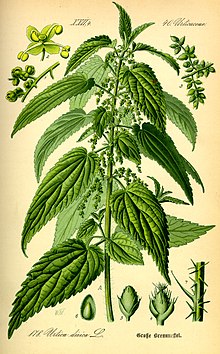This is stinging nettle after it flowers. The plant has six
subspecies and five have many hollow stinging hairs called trichomes on the
leaves and stems that act like hypodermic needles, injecting histamine
and other chemicals that produce a stinging sensation when touched.
Hydrocortisone cream, calamine lotion and a paste made of baking soda with a little water may provide relief. Anything touching the rash can inflame it again. Stinging Nettles tea has a long history of medicinal use for allergies, asthma and bronchitis.
Nettles As a Food Source
Native Americans harvested the plants, before they blossom and go to seed, when other food sources were scarce. Soaking stinging nettles in water or cooking removes the stinging chemicals from the plant, which allows them to be handled and eaten without incidence of stinging. After the stinging nettle enters its flowering and seed setting stages the leaves develop gritty particles which can irritate the urinary tract.
The flavor is similar to spinach and cucumber when cooked and is rich in vitamins A, C, iron, potassium, manganese, and calcium. At the peak of the season, nettle contains up to 25% protein, dry weight, which is high for a leafy green vegetable. An herbal tea can be made after drying the leaves. Nettles is very popular in Northern India as a vegetable cooked with Indian spices.
In the Garden
Stinging Nettles attracts beneficial insects and also adds nitrogen when composted. Although low in phosphate, soaking it in a bucket of water for a few days makes a liquid fertilizer that supplies magnesium, sulphur and iron.
Nettle Rash
Stinging Nettles
Lizolivia
Hydrocortisone cream, calamine lotion and a paste made of baking soda with a little water may provide relief. Anything touching the rash can inflame it again. Stinging Nettles tea has a long history of medicinal use for allergies, asthma and bronchitis.
Nettles As a Food Source
Native Americans harvested the plants, before they blossom and go to seed, when other food sources were scarce. Soaking stinging nettles in water or cooking removes the stinging chemicals from the plant, which allows them to be handled and eaten without incidence of stinging. After the stinging nettle enters its flowering and seed setting stages the leaves develop gritty particles which can irritate the urinary tract.
The flavor is similar to spinach and cucumber when cooked and is rich in vitamins A, C, iron, potassium, manganese, and calcium. At the peak of the season, nettle contains up to 25% protein, dry weight, which is high for a leafy green vegetable. An herbal tea can be made after drying the leaves. Nettles is very popular in Northern India as a vegetable cooked with Indian spices.
In the Garden
Stinging Nettles attracts beneficial insects and also adds nitrogen when composted. Although low in phosphate, soaking it in a bucket of water for a few days makes a liquid fertilizer that supplies magnesium, sulphur and iron.
Nettle Rash
Stinging Nettles
Lizolivia



No comments:
Post a Comment